Content
- 1 Purpose and benefits of vaccination
- 2 Vaccination time in spring
- 3 What to choose as a rootstock
- 4 What can be grafted on an apricot
- 5 Selection and preparation of scion
- 6 What are the methods of grafting apricot
- 7 Follow-up care of grafted cuttings
- 8 Reasons for possible failures when grafting an apricot
- 9 Conclusion
Apricot cuttings have good engraftment. They can be grafted on a dry, warm, but not sunny day. Summer is considered a good time. In autumn, there is a high risk of scion death in the event of early frosts. Spring is considered the ideal time for grafting apricots. The active phase of sap flow begins near the tree. The graft quickly grows together with the stock and manages to get stronger before the onset of cold weather.
Purpose and benefits of vaccination
A feature of stone fruit trees is their short life span. To preserve their favorite variety, gardeners are vaccinated. The process benefits the owners of small plots. Grafting allows you to get different varieties on the same tree, even differing in ripening terms.
Most varieties of apricots are adapted to warm climates. Grafting on a winter-hardy stock allows you to increase the frost resistance of the variety. The gardener is given the opportunity to grow a culture in a cold region, while receiving good fruits without changing the taste.
Vaccination time in spring
Not every spring stock takes root equally well. A good time is considered when the apricot has not yet begun sap flow. There should be about two weeks before this period. The grafted cuttings after the beginning of the movement of the juice take root worse, but most often they dry out. It is impossible to determine the exact date. It all depends on the weather conditions of the region. On average, the successful period for vaccination falls on the end of March - beginning of April. Only an experienced gardener is able to accurately capture the moment.
Late inoculation is accompanied by copious sap. Upon contact with oxygen, it is oxidized. The scion cut with the stock does not grow together and gradually dry out.
What to choose as a rootstock
The main rule for choosing a stock is group compatibility. Apricots are planted only on stone fruit trees... However, even such a relationship does not guarantee 100% engraftment in all cultures.
Stock selection rules
For the stock, seedlings up to ten years old are chosen. The younger the tree, the more plastic the wood is. When connected, the tissues grow together better. However, no one has yet succeeded in obtaining a 100% result of the engraftment of stone fruit trees. To get a positive result, several rootstocks are used, preferably from different crops.
It is better to choose wild varieties of apricots as a stock.A varietal tree will acquire winter hardiness, will be resistant to drought, and will give the owner less trouble to care for. If the soil on the site has high acidity, then the apricot will grow poorly. Here it is better to choose cherry plum or plum for the stock. The good compatibility of the apricot with these trees is evidenced by small growths at the junctions of the branches.
Lack of vaccination on plum or cherry plum is the tendency of trees to sprout up a lot of growth from the roots, taking nutrients. For successful engraftment of cuttings, apricots are cut off all emerging young growth.
In the video, the methods of vaccination on a plum:
Choose wild thorn for rootstock can only be experienced gardeners. The apricot grafting process will be complex, lengthy, and will consist of two stages. First, thorny is attached to the wild thorn. After its engraftment, an apricot stalk is grafted. The popularity of the complex process is due to the production of a hardy tree.
Cherry also works well as a rootstock, but the tree is less popular due to its fragility. The crown does not withstand a large mass of the crop and begins to break. The best result is obtained after grafting plums or cherry plums to cherries, and apricots are already attached to them. However, the process is very long and does not justify the efforts of the gardener.
How to plant an apricot on an apricot in spring
The compatibility of the cuttings with the stock is ideal. Despite the best qualities of other stone fruit trees, the cultivar with wild apricot has a high survival rate. This is reflected in the future winter hardiness of the tree, the palatability of the fruit, and drought resistance.
How to plant an apricot on a plum in spring
For the stock, it is advisable to choose a half wild plum variety. In addition to better engraftment, the graft tolerates frost better. On the plum needs to be grafted more than one grade. Skeletal branches are chosen as a place, stepping back about 300 mm from the main trunk.
Grafting apricot on a turn
In order to avoid the complicated process with a double grafting, it is better to choose a thorny rootstock right away. When using wild thorns, the first graft is made at the root system itself. The method allows to reduce the amount of young growth.
Is cherry plum suitable as a stock
The popularity of the apricot pin for cherry plum is justified by the improvement in the taste of orange fruits. In particular, sweetness is enhanced. The engraftment of cuttings is no worse than for a plum.
Benefits of grafting apricot on dwarf rootstocks
Small trees are called dwarf trees. The advantage of such a rootstock is to transfer part of its genes to the scion. The advantages of grafting an apricot onto a dwarf stock are as follows:
- a thermophilic apricot tolerates early spring frosts more easily, is less affected by diseases;
- the first fruiting can occur two years after vaccination;
- there is an enlargement of the fruits, an increase in the brightness of the color;
- it is easier to harvest from a low-growing apricot, it is easier to cut off branches, and spray from pests.
The best stocks were "Alab - 1" and "VVA-1". Quite good compatibility with Vavit, as well as Pumiselekt.
Which trees are not suitable for grafting apricots
Complete incompatibility can be said for pome and stone fruit crops. An apricot will not take root on an apple or pear... Even if the stalk initially shows signs of life, it will dry out over time.
Irga is a good winter-hardy stock, but is similarly suitable only for pome crops. The apricot graft will not take root.
Rowan with plum belong to the same subfamily. This is a great rootstock, but also not for an apricot.
Cherry is considered a compatible stock, but there are many negative aspects. In addition to the fragility of the future tree, the rootstock and the scion grow together poorly. Not all cherries are suitable for grafting, even if you pinch a plum first.
What can be grafted on an apricot
When used as a rootstock, apricots adhere to the same stone fruit compatibility.Usually another variety of apricots or plums is planted.
Peach grafting on apricot
Apricot and peach have ideal compatibility. The best time to get vaccinated is early spring, around mid-March. However, warm days should be established outside without the return of night frosts. In the last days of March - early April, the vaccine is wrapped in foil. In May, a paper bag shelter is additionally used. In summer, peach can also be grafted. This is done in early June or mid-July.
Frost-resistant semi-wild varieties of apricots are considered a universal stock. The winter hardiness of the peach increases, the growth accelerates, and early fruiting begins. The vegetation of the peach ends earlier from the apricot, which is why the young branches have time to ripen before the onset of frost. An excellent rootstock is the variety "Greensboro", "Veteran", "Juicy".
Selection and preparation of scion
Apricot cuttings are best harvested in the fall. In winter, young shoots can partially freeze out or simply hypothermic. The result will be bad from such a scion.
Harvesting, storage conditions and preparation of the scion
Cuttings for grafting are cut from annual branches 5 mm thick. The length of the scion is made from 10 to 15 cm. It is important that the stalk contains at least 5 - maximum 10 live buds. The cut branches are saved so that they do not enter the awakening phase until spring. The scion is stored in a refrigerator or cellar, where the air temperature does not exceed +2aboutC. Allow the temperature to drop below 0aboutC in the storage place of cuttings is also impossible. The graft will die.
If you store apricot cuttings in high humidity, the bark will begin to rot and the buds will disappear. The beginning of the process is difficult to determine in appearance. In the spring, before the start of vaccination, the stalk is examined for delight. The lower bud is cut from the scion, separated with a knife for examination. Green indicates vitality.
Gardeners practice soaking apricot cuttings in water the day before grafting. The graft will be saturated with moisture, wake up, the metabolism with the stock will begin faster.
Preparation of tools and material
The main grafting tool is a sharp budding knife. It differs from the usual one by the even sharpening of the blade on only one side. This allows you to make perfectly even cuts at an angle.
A branded tool is expensive. If you are not professionally engaged in vaccinations, the budding knife can be made from an ordinary penknife with a blade length of 5 cm. Sharpening is done on a fine-grained grinding wheel. The cut quality is tested on any thin branches of the tree.
Pruning shears are used to harvest cuttings in the fall. The tool must have sharp blades, otherwise it will crush the twigs.
From the materials you will need a garden pitch. The vaccination site is wrapped. You can buy a special tape or simply cut strips of plastic wrap. Among novice gardeners, electrical tape is popular, used by electricians to insulate wire. It can also be used, only with a sticky layer outward. If the tape sticks to the graft, it will rip off the young bark when unwinding.
What are the methods of grafting apricot
Gardeners use six methods of grafting apricots. Each of them has its own advantages and disadvantages. It is optimal to test all methods and choose one for yourself, in which the cuttings take root best.
Copulation
The peculiarity of copulation is the use of cuttings and rootstocks of the same diameter. The maximum thickness of branches is allowed - 15 mm. The stock can be a tree no older than two years. A prerequisite is to execute the same slice on two branches:
- one length;
- at one angle;
- one cut of the knife.
When folding the two pieces, you should get a twig, as if it had not been cut.
Apricots are copulated in the last days of March or the first ten days of April, if there are still frosts on the street. The process consists of the following steps:
- inspect and wipe the section of the branch for inoculation with a clean rag;
- attaching the budding knife, make a cut on themselves at an acute smooth angle;
- a similar cut is made on an apricot stalk under the lower bud;
- the two parts are connected together so that the sections fit tightly;
- the vaccine is tightly wrapped with tape.
The end of the copulation is to cut the top of the cuttings with a pruner and process this place with garden pitch.
The video shows apricot copulation:
Grafting into cleft
If apricot cuttings are grafted onto an adult tree, the thickness of the branches will not match. The rootstock of a larger diameter and a thinner graft are always taken. The end of March - the first days of April is similarly chosen as the time for vaccination.
The cleft grafting method involves the following actions:
- the lower part of the cutting with an budding knife is cut off from both sides to make a wedge;
- the tree chosen for the stock is cut down so that the bark on the remaining hemp is not damaged;
- a knife is placed in the center of the hemp and with a smooth but strong pressure they try to split wood up to 10 cm deep;
- a stalk is inserted into the resulting cleavage with a wedge, observing the coincidence of the bark;
- the cleavage site is tightly pulled together with a tape, treated with garden pitch.
If the stock is very thick, then two apricot cuttings can be inserted. You just need to combine the bark on both sides. Over time, if two cuttings of apricots take root, the weak graft is removed.
Kidney vaccination (budding)
The easiest way is for beginners. The bottom line is that it is not the stalk that is grafted, but only the kidney. An important condition for engraftment is a plus round-the-clock temperature. Apricot buds are inoculated no earlier than mid-April. It should already begin to awaken, but not yet unravel.
The process consists of the following steps:
- a site with a young smooth bark is selected on the stock, an incision is made in the shape of the letter "T";
- a bud with bark is cut from a fresh scion with a knife, capturing a thin layer of wood;
- on the rootstock, the bark is carefully turned off, the bud is inserted, the grafting is wrapped with tape and treated with garden varnish.
Only the cut points should be wrapped with tape. The top of the bud should look out, as the shoot will grow from it. During budding, do not touch the cut sites with your fingers. Engraftment may deteriorate or an infection may occur.
How to graft an apricot graft into the bark
Grafting of apricot cuttings for the bark is carried out in the spring with the beginning of the movement of the juice. The method is used when the rootstock diameter is greater than the scion thickness. To carry out the vaccination, perform the following steps:
- Depending on the thickness of the stock, prepare the required number of cuttings. Usually they take from 2 to 4 pieces. The lower part of the branches is cut with a wedge, but only on one side. It turns out a transverse wedge.
- The tree prepared for the stock is carefully cut down so as not to damage the bark. Burrs and protrusions are cut with a knife.
- The bark of the stock is cut to a depth of 5 cm. The sides are pushed apart on the sides and an apricot stalk is inserted into the pocket. The wedge should press firmly against the wood.
When all the cuttings are inserted in this way, the stump is tightly wrapped with tape, treated with garden pitch.
Side cut
The method is used in the cultivation of wild varieties, as well as to increase the yield of an adult tree. A side-cut clothespin is performed from mid-April.
The principle of the method is as follows:
- the lower part of the cutting apricots are cut under a wedge on both sides;
- a lateral cut is made on the bark of the stock with a knife, slightly grabbing the wood;
- The stalk is inserted into the pocket with a wedge, the cut is wrapped with tape, and treated with garden pitch.
From the top of the cutting, 15 mm are cut with a pruner, and this place is also smeared with pitch.
The Bridge Method Will Help Save Damaged Trees
In winter, hares love to gnaw the bark of fruit trees. In the spring, the apricot can die if rescue measures are not taken in time. At the end of March - early April, a bridge is installed at the site of damage:
- The top and bottom of the bark of the damaged area are leveled with a knife. Slots about 3 cm in length are made vertically opposite each other. The distance between them is kept 2 cm.
- Apricot cuttings are cut with a wedge at both ends, inserted inside with a pocket, connecting the upper and lower parts of the tree bark.
- The finished bridge is wrapped with tape, treated with garden varnish. The bandage is not removed until autumn.
The cuttings bridge will transfer nutrients from the roots to the tree.
Follow-up care of grafted cuttings
In order for a grafted apricot twig to take root, it needs to be given strength. Care is performed according to the following rules:
- shoots are removed from the roots of the tree, which draws out the juices for their growth;
- the stock is often watered, fertilized, and the ground is not allowed to dry out;
- foliage blossoming on the cutting is sprayed with drugs for pests and diseases.
The next spring, the grown stalk begins to form with the help of pruning.
Reasons for possible failures when grafting an apricot
Often the reason for poor engraftment of apricot cutting is a dirty tool. It is unacceptable to get into the cut of infection, fatty oils, dust. The second mistake of unsuccessful vaccination is performing the procedure on a rainy or just wet day. The third reason is considered to be a violation of the rules for caring for a tree after vaccination.
Conclusion
Planting an apricot is more difficult than planting a pear. Cuttings take root more difficult. However, you have to try, follow the rules, choose the appropriate method. At the first failure, do not give up. Errors should be analyzed so as not to repeat them for the next season.
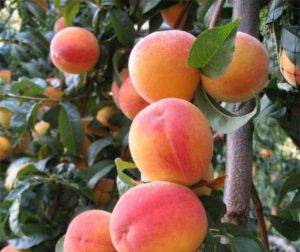
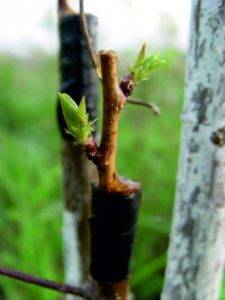
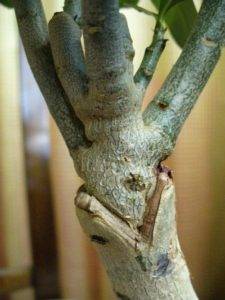

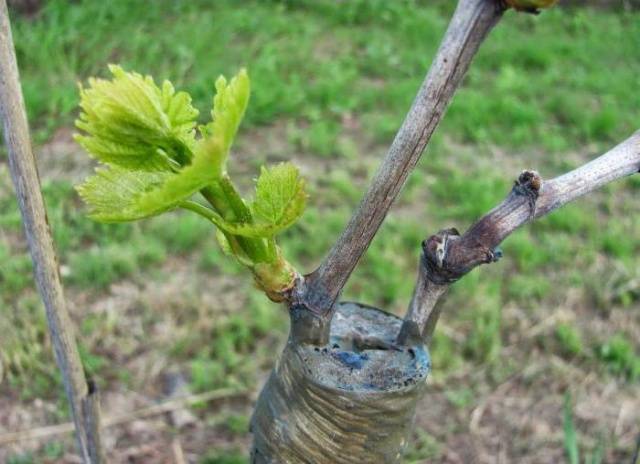
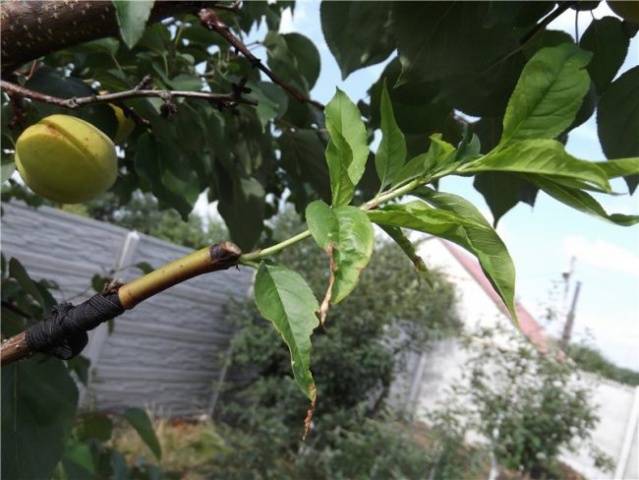
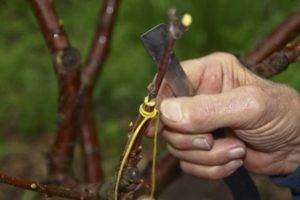


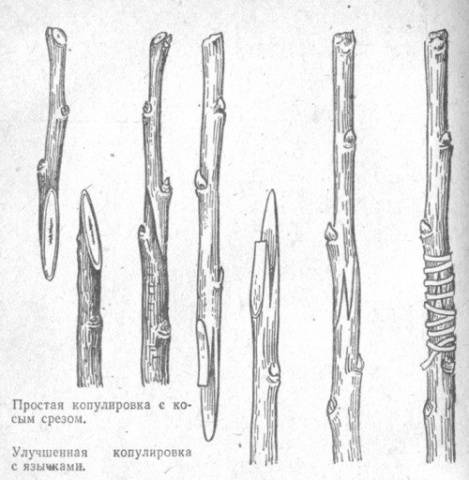
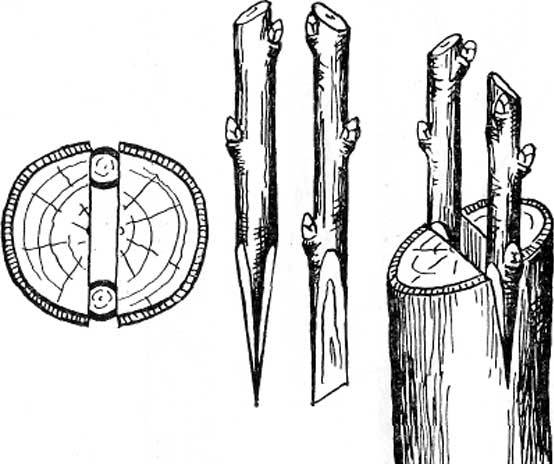
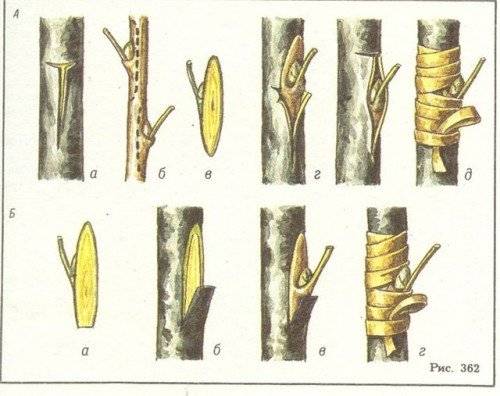


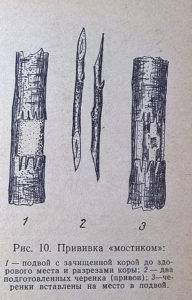

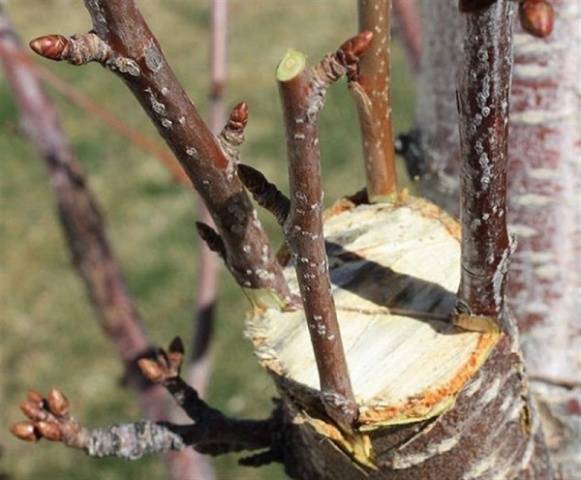









Thanks for the simple and clear explanation.